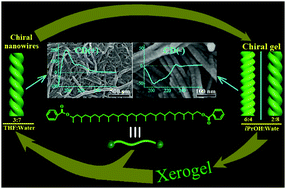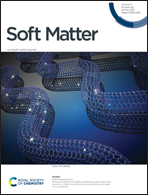Benzoate ester as a new species for supramolecular chiral assembly†
Abstract
In this work, a benzoate ester molecule, dodecamethylnonacosane-2,28-diyl dibenzoate (DMNDB), has been discovered as a new species that aggregates into chiral nano-assemblies. In the tetrahydrofuran (THF)/water system, the benzoate ester, DMNDB, could self-assemble into left-handed twisted nanowires, and the most suitable THF/water volume ratio to obtain uniform twisted nanowires was 3 : 7. The driving forces of assembly and the molecular packing type in assemblies for the twisted nanowires were explored, and a possible assembly mechanism was proposed to understand the generation of chiral assemblies. Interestingly, the left-handed nanowires could cross-link and immobilize the solvent in the isopropanol (iPrOH)/water (2 : 8) system to form chiral gels. When the iPrOH/water ratio was increased to 6 : 4, the left-handed nanowires as structural units were found to evolve to right-handed nanofibers. Accordingly, the intermolecular interactions and the molecular packing type also changed with the solvent ratio. What is more, the xerogel could be obtained by drying the gel and left-handed twisted nanowires could form in the THF/water system again, showing the recyclability of chiral nanoassemblies. Also, these DMNDB chiral nanostructures exhibited potential for application in enantioselective separation by co-assembling with tetra-aniline.



 Please wait while we load your content...
Please wait while we load your content...